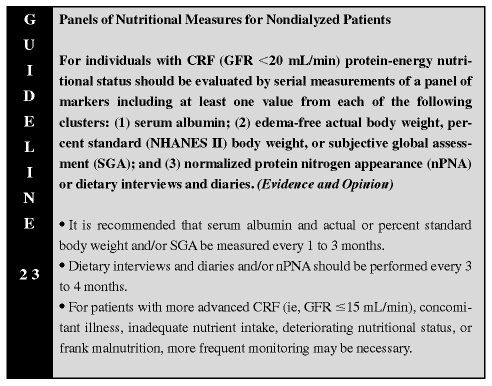

Deterioration of nutritional status often begins early in the course of CRI, when the GFR is as high as 28 to 35 mL/min/1.73 m2 or greater.196-198 As a result, frank PEM is frequently present at the time that individuals commence MD therapy.16,23,128 Malnutrition in patients commencing MD is a strong predictor of poor clinical outcome.22,23,79,199 Thus, it is important to prevent or correct PEM in patients with progressive CRF, although randomized prospective clinical trials to test this hypothesis are not available. Methods for estimating or measuring GFR are discussed in Appendix IX.
The use of effective techniques to monitor nutritional status is an essential component of protocols to prevent or treat malnutrition in individuals with progressive CRI or CRF. Serum albumin, a measure of body weight-for-height (eg, %SBW), SGA, and assessment of dietary intake are all recommended because of the extensive experience with these indices and each is predictive of future morbidity and mortality in individuals with CRI or CRF or patients on MD. Serum albumin and prealbumin are indicators of visceral protein mass as well as inflammatory status and have been used extensively in persons with or without renal disease to assess nutritional status.17,42 Moreover, hypoalbuminemia and low serum prealbumin at the initiation of dialysis are predictive of increased mortality risk.19,42,44,145,199
For the nondialyzed patient with chronic renal failure, there are much more data relating serum albumin rather than serum prealbumin concentrations to outcome. Also, since serum prealbumin levels are affected by the GFR,17 variations in renal function may confound the results. Therefore, although either measurement could be used to assess the nutritional or inflammatory status of the CRI or CRF patient, the serum albumin may be the preferred measurement.
Reduction in body weight below reference values correlates with the loss of somatic protein, as well as increased risk of hospitalization, postoperative complications, and mortality.15,85 In MD patients, evidence of moderate to severe malnutrition as determined by SGA is associated with increased mortality.16,79,200,201 Measurements of dietary interviews/diaries and nPNA are recommended because these measures can detect inadequate nutrient intake, which predicts poor outcome and is also a key cause of PEM (see Appendices III, V, and VI ).